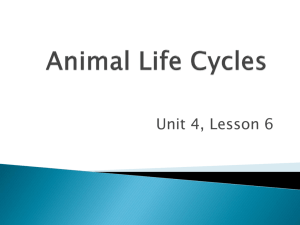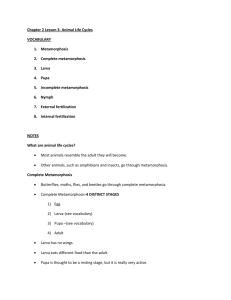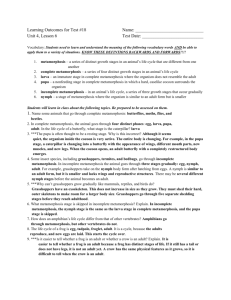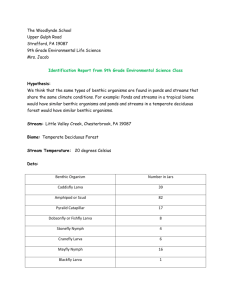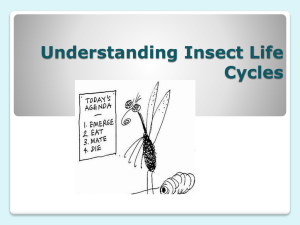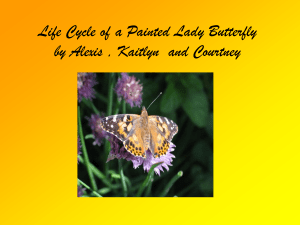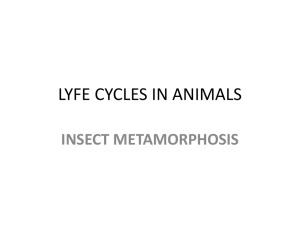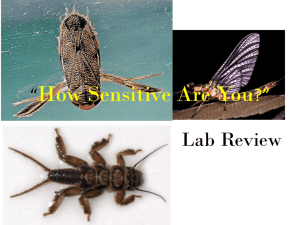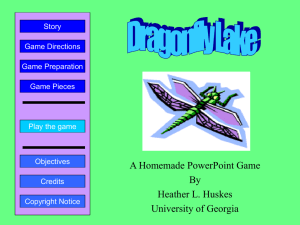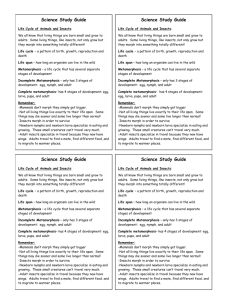Animals
advertisement
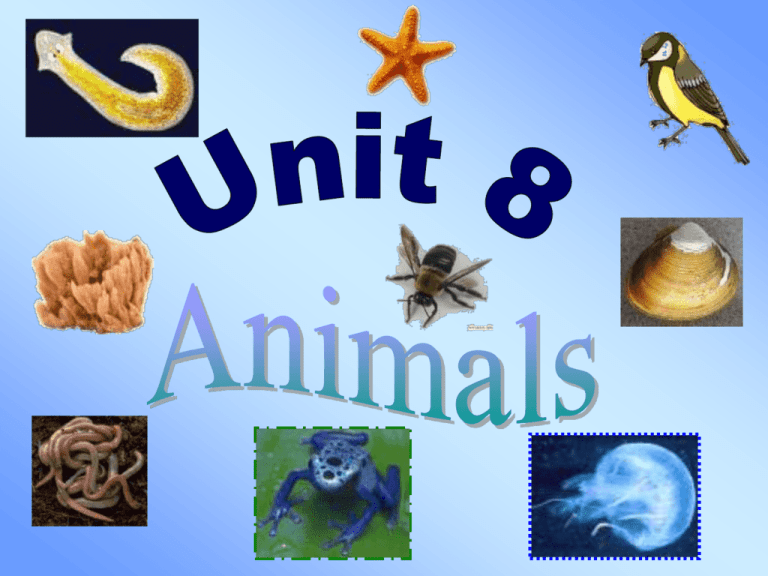
Objectives • Know the main characteristics of animals • Know the difference between invertebrate and vertebrates • Know examples and characteristics of the 8 invertebrate phylum • Know the main characteristics of the 5 vertebrate classes • Know the difference between endotherm and ectotherm • Know what fertilization and development are • Know complete and incomplete metamorphosis • Main Characteristics – – – – – multi-cellular eukaryotic (nucleus) no cell wall move on their own consumers Invertebrates Invertebrates are animals without a backbone. hydra There are 8 invertebrate phyla. leech sponge Sea anemone 8 Phyla • Sponges • Cnidarians (Coelenterates) • Flatworms • Round worms • Segmented worms • Mollusks • Arthropods • Echinoderms Sponges • • • • • osculum Many pores Move slowly No gut, no nerves Reproduce asexually by budding Regenerate (replace body parts) Eating: - Water enters pores - collar cells filter food - water is removed by osculum (hole) Cnidarians • Tentacles with stinging Hydra reproducecells (nematocysts) asexually by • 2 cell layers thick budding • Gut for digesting food • Nerve net Coral (live in colonies) Flatworm • • • • Very thin, flat body Eyespots 3 cell layers thick Sensory lobes to detect food • Some are parasites • Nerves fluke Draw the head of the planaria. Label the following parts: eyespots sensory lobes Roundworm • Round, smooth body • 2 body openings • Primative brain heartworm • Parallel nerve cords • Parasites pinworm Ascaris hookworm Trichinella- found in uncooked pork slug: no shell mussel • Most have a soft body with a hard shell clam: two shells (bivalve) • Have a mantle: tissue that produces shell. • Have a foot: used to move squid octopus cephalopods: head-footed Annelids (Segmented worms) • • • • Body has segments Have a coelom (body cavity for organs) 2 body openings Circulatory system, brain and nerve cord leech earthworm clitellum (helps with reproduction) shrimp Crustacean • • • • grasshopper Insect tick Arachnids Jointed limbs Body in segments (head, thorax & abdomen) Exoskeleton (external skeleton for protection) Compound eye Insect millipede Centipede & Millipede bee crab Crustacean butterfly (Insect) lobster (Crustacean) centipede (Centipedes & Millipedes) ladybug (Insect) spider (Arachnids) starfish sand dollar • Spiny-skinned • Endoskeleton (internal skeleton) • Tube feet Tube feet • Simple nervous system • Simple eye that senses light brittle star sea urchin sea cucumber Vertebrates are animals with a backbone. There are five classes of animals in the Chordate Phylum. Ectotherms – Cold-blooded – Body temperature can change slightly with the surroundings • Bony Fish • Amphibians • Reptiles Endotherms – Warm-blooded – Body temperature remains constant regardless of their surroundings • Birds • Mammals Fertilization The union (joining) of egg and sperm. Can be: Internal – inside the body Development The growth of a new External – outside the body organism before birth. Internal – inside the body External – outside the body http://www2.hu-berlin.de/sexology/ECC2/html/fertilization.html Main Characteristics: • • • • Ectotherms Use gills to breathe Live in water Covered with scales salmon trout Sexual Reproduction: catfish - Lay soft eggs in water - External fertilization - External development newt toad Main Characteristics: • • • • Ectotherms Breathe with gills then lungs Live in water then land Breathe through moist skin salamander Sexual Reproduction: frog - Lay soft eggs in water - External fertilization - External development snake Main Characteristics: • • • • • Ectotherms Breathe with lungs Live in water or land Covered with dry scaly skin or shell Shed skin to grow crocodile lizard Sexual Reproduction: lizard turtle - Lay hard shell eggs on land - Internal fertilization - External development Main Characteristics: • • • • • Endotherms Use lungs to breathe Live in water, land, or air Covered with feathers Have wings Sexual Reproduction: - Lay hard shell eggs on land - Internal fertilization - External development condor Main Characteristics: • • • • Endotherms Breathe with lungs Live in water or on land Covered with hair or fur Sexual Reproduction: - Born alive - Internal fertilization - Internal development The process of an animal changing forms from an embryo (egg) or larva to an adult. Incomplete Metamorphosis 3 stages: - egg - nymph - adult Nymph looks like the adult. Complete Metamorphosis 4 stages: - egg - larva - pupa - adult Larva looks different than the adult. The process of an animal changing forms from an embryo (egg) or larva to an adult. Incomplete Metamorphosis 3 stages: - egg - nymph - adult Nymph looks like the adult. Complete Metamorphosis 4 stages: - egg - larva - pupa - adult Larva looks different than the adult. Complete Adult Eggs Pupa Larva Click here to return to notes Young frog Adult frog Tadpole frog Complete Metamorphosis Tadpoles: Adult frogs: • Live in water • Live on land • Use gills • Use lungs • Have a tail • Have legs Tadpole Egg Egg mass Click here to return to notes Incomplete Adult Nymph Eggs Click here to return to notes The process of an animal changing forms from an embryo (egg) or larva to an adult. Incomplete Metamorphosis 3 stages: - egg - nymph - adult Nymph looks like the adult. Complete Metamorphosis 4 stages: - egg - larva - pupa - adult Larva looks different than the adult.
